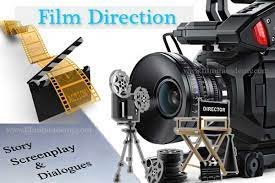Script Editor (1 years diploma)
Script Editor click here
Brief Job Description: Individuals at this job read and assess the script for the
merit of the story, its dramarurgy and overall competence and offer feedback
and notes for improvement to make the script production worthy.
Personal Attributes: This job requires the individual to have a sound
understanding of the craft of screenwriting. The individual must be able to read
a script and understand the premise and intention embedded in the story. The

individual must be able to assess the script and narrative style and identify areas
of improvement to enhance the impact and quality of the script. The individual
must be well-versed with script-writing elements, principles, norms, guidelines
and techniques.
Description
Budget Budget is an estimate of the total cost of production that may include a
break-up of cost components
Continuity Continuity represents the seamless transition from one shot to another
Copyright Laws A legal framework linked to intellectual property and the rights given to
creators of original products/ concepts
Screenplay Screenplay is the script coupled with key characteristics of the scene and
directions for acting
Script Script is a structured narrative of a story
Sector Sector is a conglomeration of different business operations having similar
businesses and interests. It may also be defined as a distinct subset of the
economy whose components share similar characteristics and interests.
Sub-sector Sub-sector is derived from a further breakdown based on the
characteristics and interests of its components.
Target Audience Group of people at whom content/ adverting is aimed. A target audience
is typically defined by age, gender, economic classification, geography
and any other relevant parameters (e.g. Females, aged 25-40, average
monthly household income INR 25,000-50,000, from Hindi speaking
states in North India)
Vertical Vertical may exist within a sub-sector representing different domain
areas or the client industries served by the industry.
Occupation Occupation is a set of job roles, which perform similar/related set of
functions in an industry
Function Function is an activity necessary for achieving the key purpose of the
sector, occupation, or area of work, which can be carried out by a person
or a group of persons. Functions are identified through functional
analysis and form the basis of OS.
Sub-functions Sub-functions are sub-activities essential to fulfill the achieving the
objectives of the function.
Job role Job role defines a unique set of functions that together form a unique
employment opportunity in an organization.

Occupational Standards
(OS)
OS specify the standards of performance an individual must achieve
when carrying out a function in the workplace, together with the
knowledge and understanding they need to meet that standard
consistently. Occupational Standards are applicable both in the Indian
and global contexts.
Performance Criteria Performance Criteria are statements that together specify the standard
of performance required when carrying out a task
National Occupational
Standards (NOS)
NOS are Occupational Standards which apply uniquely in the Indian
context.
Qualifications Pack
Code
Qualifications Pack Code is a unique reference code that identifies a
qualifications pack.
Qualifications Pack(QP) Qualifications Pack comprises the set of OS, together with the
educational, training and other criteria required to perform a job role. A
Qualifications Pack is assigned a unique qualification pack code.
Unit Code Unit Code is a unique identifier for an Occupational Standard, which is
denoted by an
Unit Title Unit Title gives a clear overall statement about what the incumbent
should be able to do.
Description Description gives a short summary of the unit content. This would be
Qualifications Pack For Script Editor
helpful to anyone searching on a database to verify that this is the
appropriate OS they are looking for.
Scope Scope is the set of statements specifying the range of variables that an
individual may have to deal with in carrying out the function which have
a critical impact on the quality of performance required.
Knowledge and
Understanding
Knowledge and Understanding are statements which together specify the
technical, generic, professional and organizational specific knowledge
that an individual needs in order to perform to the required standard.
Organizational Context Organizational Context includes the way the organization is structured
and how it operates, including the extent of operative knowledge
managers have of their relevant areas of responsibility.
Technical Knowledge Technical Knowledge is the specific knowledge needed to accomplish
specific designated responsibilities.
Core Skills/Generic
Skills
Core Skills or Generic Skills are a group of skills that are key to learning
and working in today’s world. These skills are typically needed in any
work environment. In the context of the OS, these include
communication related skills that are applicable to most job roles.
Description
NOS National Occupational Standard(s)
QP Qualifications Pack
NSQF National Skill Qualifications Framework
NVEQF National Vocational Education Qualifications Framework
NVQF National Vocational Qualifications Framework
Adapt the script to production requirements
Description This OS unit is about assessing the script to identify areas of improvement and
adapting/re-writing/refining the script to make it suitable for production
Scope This unit/task covers the following:

Assessing and editing scripts for a range of productions and genres
Productions could include animation, advertisements/commercials,
documentaries, feature films, short films, television series, theatre
Genres could include action, children, comedy, crime, drama, family,
history, horror, romance, science fiction, teens, thriller
Performance Criteria (PC) w.r.t. the Scope
Element Performance Criteria
Assessing and editing
scripts for a range of
productions and
genres
To be competent, the user/individual on the job must be able to:
PC1. Analyse the script to identify areas where the creative merit of the story is
not emerging, keeping commercial success and the requirements of the
production house in view
PC2. Assess and analyse the different script-writing elements (such as premise,
plot, character, structure, scene design) to ensure that they are all woven
together into a seamless whole
PC3. Relate the script to the genre in which it is set and confirm the consistency of
mood maintained therein
PC4. Develop a plan for re-writing and refining the script to make it productionready
PC5. Re-write/refine the script and narrative in a timely manner following
feedback, liaise with colleagues to resolve contradictory comments, and
finalise it for production (Optional)
Knowledge and Understanding (K)
A. Organizational
Context
(Knowledge of the
company /
organization and
its processes)
The user/individual on the job needs to know and understand:
KA1. The objective/outcomes of the production e.g. audience engagement with
commercial success in view for feature films, public service, information
dissemination and spreading awareness
KA2. The timelines and budget within which the final script would need to be
delivered
B. Technical
Knowledge
The user/individual on the job needs to know and understand:
KB1. How to assess scripts and narrative styles, diagnose weaknesses and identify
changes required

KB2. Principles of story-telling and character psychology
KB3. How to locate the scripts premise, assess it for its dramatic strength and
clarity and match it to the version approved by the production house
KB4. How to assess the unity of the script i.e. to ensure that all key sequences
draw their dramatic energy from the central idea/ premise
KB5. How to confirm the integrity between the character and the plot
KB6. How to assess if the screenplay’s structure is in line with requirements and if
there is accessible clarity to the narrative’s progression
KB7. How to assess every scene to confirm if the division is correct vis-à-vis time
and location and to evaluate its placement in the progression of the
screenplay
KB8. How to examine dialogues for their rhythm, uniqueness of voice, economy of
style and assess if they serve in driving the narrative forward and in revealing
the characters
KB9. Concepts relating to general topics (like history, mythology, politics,
technology) to identify gaps in logic, authenticity and credibility
KB10. Elements of the script i.e. character, conflict, premise, story, narrative
structure, causality, turning points, story development, story set-ups in
opening sequence, genre, plot and story, setting, structure and theme
KB11. How to work on word processing software and scriptwriting, formatting
software like Final Draft, Movie Magic and Celtx
KB12. How to type in regional languages using Unicode
KB13. Applicable copyright norms and intellectual property rights to protect work
and sign contracts
KB14. Applicable health and safety guidelines
Skills (S) (Optional)
A. Core Skills/
Generic Skills
Writing Skills
The user/individual on the job needs to know and understand how to:
SA1. Diagnose changes and identify areas of improvement in the script
SA2. Crystalise the premise, summarise the script and give detailed and relevant
notes for revising/ redrafting the script
SA3. Use correct grammar, spelling, punctuation and phonetics for the language in
which the script is being developed
Reading Skills
The user/individual on the job needs to know and understand how to:
SA4. Read and understand the production premise, and check for its dramatic
strength and clarity
SA5. Read and assess the script keeping in mind aspects such as the genre, target
audience, region, culture and time period
Oral Communication (Listening and Speaking skills)
The user/individual on the job needs to know and understand how to:
SA6. Discuss/negotiate and agree on the areas of improvement on the script with
the Director, Producer and Script-writer
A7. Present versions of edited scripts with the Director, Producer and Scriptwriter to finalise the script
SA8. Be well-networked within the industry
B. Professional Skills Plan and Organize
The user/individual on the job needs to know and understand how to:
SB1. Ensure that the script is ready for production and is completed within
timelines and budget requirements
Problem Solving
The user/individual on the job needs to know and understand how to:

SB2. Identify any problems with successful execution of the task and resolve them
in consultation with the producer and director
Analytical Thinking
The user/individual on the job needs to know and understand how to:
SB3. Envision the impact of the script on the production budget, requirements and
process
Critical Thinking
The user/individual on the job needs to know and understand how to:
SB4. Critically review the script to identify areas of improvement
Maintain workplace health and safety
Description This OS unit is about contributing towards maintaining a healthy, safe and secure
working environment
Scope This unit/task covers the following:
Understanding the health, safety and security risks prevalent in the workplace
Knowing the people responsible for health and safety and the resources available
Identifying and reporting risks
Complying with procedures in the event of an emergency
Performance Criteria (PC) w.r.t. the Scope
E
lement Performance Criteria
Understanding the
risks prevalent in the
workplace
To be competent, the user/individual on the job must be able to:
PC1. Understand and comply with the organisation’s current health, safety and
security policies and procedures
PC2. Understand the safe working practices pertaining to own occupation
PC3. Understand the government norms and policies relating to health and safety
including emergency procedures for illness, accidents, fires or others which
may involve evacuation of the premises
PC4. Participate in organization health and safety knowledge sessions and drills
Knowing the people
responsible for health
and safety and the
resources available
PC5. Identify the people responsible for health and safety in the workplace,
including those to contact in case of an emergency
PC6. Identify security signals e.g. fire alarms and places such as staircases, fire
warden stations, first aid and medical rooms
Identifying and
reporting risks
PC7. Identify aspects of your workplace that could cause potential risk to own and
others health and safety
PC8. Ensure own personal health and safety, and that of others in the workplace
though precautionary measures
PC9. Identify and recommend opportunities for improving health, safety, and
security to the designated person

PC10. Report any hazards outside the individual’s authority to the relevant person
in line with organisational procedures and warn other people who may be
affected
Complying with
procedures in the
event of an
emergency
PC11. Follow organisation’s emergency procedures for accidents, fires or any other
natural calamity in case of a hazard
PC12. Identify and correct risks like illness, accidents, fires or any other natural
calamity safely and within the limits of individual’s authority
Knowledge and Understanding (K)
A. Organizational
Context
(Knowledge of the
company /
organization and
The user/individual on the job needs to know and understand:
KA1. Organisation’s norms and policies relating to health and safety
KA2. Government norms and policies regarding health and safety and related
emergency procedures
KA3. Limits of authority while dealing with risks/ hazards
KA4. The importance of maintaining high standards of health and safety at a
workplace
B. Technical
Knowledge
The user/individual on the job needs to know and understand:
KB1. The different types of health and safety hazards in a workplace
KB2. Safe working practices for own job role
KB3. Evacuation procedures and other arrangements for handling risks
KB4. Names and contact numbers of people responsible for health and safety in a
workplace
KB5. How to summon medical assistance and the emergency services, where
necessary
KB6. Vendors’ or manufacturers’ instructions for maintaining health and safety
while using equipments, systems and/or machines
Skills (S) (Optional)
A. Core Skills/
Generic Skills
Writing Skills
The user/individual on the job needs to know and understand how to:
SA1. How to write and provide feedback regarding health and safety to the
concerned people
SA2. How to write and highlight potential risks or report a hazard to the concerned
people
Reading Skills
The user/individual on the job needs to know and understand how to:
SA3. Read instructions, policies, procedures and norms relating to health and
safety
Oral Communication (Listening and Speaking skills)
The user/individual on the job needs to know and understand how to:
SA4. Highlight potential risks and report hazards to the designated people
SA5. Listen and communicate information with all anyone concerned or affected
B. Professional Skills Decision making
The user/individual on the job needs to know and understand how to:
SB1. Make decisions on a suitable course of action or plan
Plan and Organize
The user/individual on the job needs to know and understand how to:
SB2. Plan and organize people and resources to deal with risks/ hazards that lie
within the scope of one’s individual authority
Problem Solving
The user/individual on the job needs to know and understand how to:
SB3. Apply problem solving approaches in different situations
Critical Thinking
The user/individual on the job needs to know and understand how to:
SB4. Understand hazards that fall within the scope of individual authority and
report all hazards that may supersede one’s authority
SB5. Apply balanced judgements in different situations







